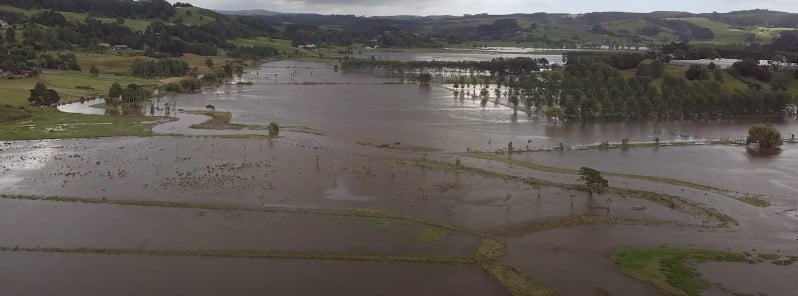When summer turned extreme: A statistical analysis of New Zealand’s remarkable summer of 2022/23

February 2023 was a month of extremes for New Zealand’s weather and climate. While some parts of the North Island received at least 400% of their normal February rainfall and experienced the 2nd wettest summer on record, the South Island faced below-normal rainfall and the 5th driest summer on record. Cyclone Gabrielle brought destructive winds and historic extreme rainfall, resulting in widespread destruction and loss of life. The nationwide average temperature was 1.1 °C (2 °F) above the February average, making it the 3rd warmest summer on record. Despite the heavy rainfall, some locations experienced high sunshine hours.
According to a statement released by New Zealand’s National Institute of Water and Atmospheric Research (NIWA), higher-than-normal air pressure was observed to the east and south of New Zealand during February, while lower-than-normal air pressure was recorded to the north and west, which is typical of La Niña summers.
As a result, more easterly and northeasterly winds than usual were experienced, drawing in warm and humid air from the tropics and sub-tropics. The combination of these factors partly explains why persistently wet and cloudy weather was experienced in the northern and eastern parts of both Islands, while sunnier and drier conditions were observed in the west and south of both islands. Adding to the warmth, humidity, and moisture availability to passing low-pressure systems was a marine heatwave (MHW) that peaked during January and rivaled the MHWs of 2017-2018 and 2021-2022.
“Summer 2022/23 was exceptional summer from a weather and climate perspective. You thought it was wet, you thought it was stormy, and you felt like you didn’t really have summer, you are right. That’s what the data is telling us. We’ve seen some remarkable statistics,” NIWA meteorologist and forecaster Ben Noll said.
Parts of the North Island received a minimum of 400% of their average February rainfall. The city of Napier had its 3rd wettest month on record, receiving over 600% of its normal rainfall, equivalent to 45% of its annual normal. The highest 1-day rainfall recorded was 316 mm (12.4 inches), observed at Tūtira in Hawke’s Bay on February 13th. Conversely, rainfall in parts of the South Island was below or well below normal, with Fiordland experiencing less than 50% of its normal rainfall.
The North Island experienced the 2nd wettest summer on record, with the Auckland region receiving over 5.5 times its average summer rainfall and 63% of its entire annual normal. On the other hand, the South Island experienced the 5th driest summer on record, and meteorological drought developed in Otago in February, with many areas receiving less than half their normal summer rainfall.
Cyclone Gabrielle brought destructive winds to parts of North Island, with 18 locations observing a record or near-record high summer wind gust. The highest wind gust was 150 km/h (93 mph), observed at Mokohinau Islands on February 12. Furthermore, extreme low-pressure readings were observed during the event, with air pressure dipping to 968 hPa at Whitianga in the Coromandel Peninsula on February 14 – the second-lowest daily minimum value recorded in the North Island since 1960.
Soil moisture levels were well above normal across most of the North Island and parts of Marlborough and Canterbury, while levels in the northern West Coast, western Tasman, the Mackenzie Basin, and Southland were below normal.
The nationwide average temperature in February 2023 was 18.5 °C (65.3 °F), 1.1 °C (2 °F) above the 1991-2020 February average. The West Coast experienced its warmest February on record, with Greymouth, Westport, and Arapito recording seven days with a daily maximum temperature above 25 °C (77 °F). The highest temperature recorded was 35.6 °C (96.1 °F), observed at Middlemarch (Otago) on February 4.
The summer of 2022/23 was also the 3rd warmest on record, with 65 locations experiencing record or near-record warm minimum temperatures. New Zealand’s waters were also part of the picture, as summer sea surface temperatures were record-breaking in the west of the South Island since at least 1982, and in the north and east of the South Island, temperatures were the 2nd highest on record.
Despite the widespread flooding and heavy rainfall, some locations experienced high sunshine hours. The sunniest four locations so far in 2023 are Central Otago (562.6 hours), West Coast (548.6 hours), Mackenzie Basin (545.4 hours), and Queenstown Lakes District (526.7 hours). Hokitika experienced twice as much sunshine as those in Dannevirke and Dargaville, for example.
References:
1 In numbers: New Zealand’s wild summer weather – NIWA – March 3, 2023
Featured image credit: NIWA


In 2019, I already predicted the more erratic weather when the magnetic north pole started to follow the path over the LOMONOSOV ridge. The consequences were confirmed in 2021 with the first bump and now in 2023 with the second bump. These natural climate changes depend on the behavior of our magnetically active star, the sun and its planets. For the earth, the positions of the magnetic poles on the earth’s crust play a decisive role, and not the number of ppm CO₂.